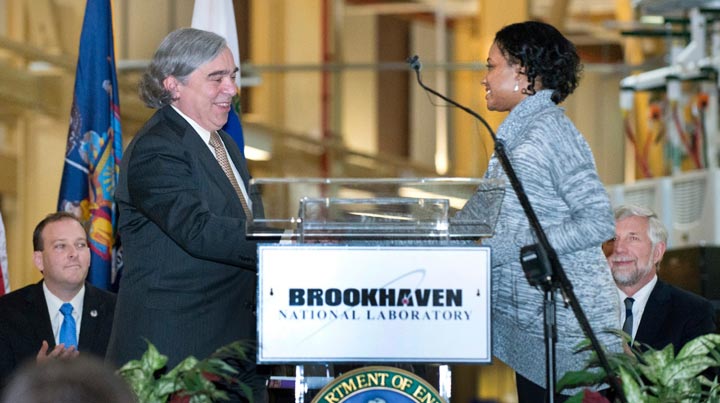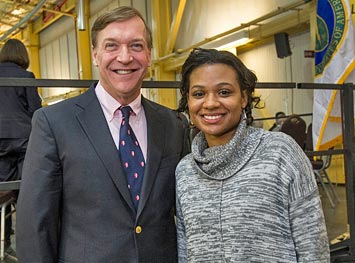NSLS-II User Profile: Melissa Sims, Stony Brook University
February 26, 2015
 enlarge
enlarge
Melissa Sims, a Stony Brook University Ph.D. student introduces Secretary of Energy Ernest Moniz at the NSLS-II Dedication Ceremony on February 6, 2015.
On February 6, 2015, Secretary of Energy Ernest Moniz dedicated the National Synchrotron Light Source II (NSLS-II), the world’s newest and brightest synchrotron light source, at Brookhaven National Laboratory. During the ceremony, held on the experimental floor of the new facility, Stony Brook University Ph.D. student Melissa Sims introduced Secretary Moniz and spoke about her research on meteorite impacts on Earth and other planets at the National Synchrotron Light Source — the now-shuttered predecessor to the new NSLS-II — and how she will continue to study geological samples at the new cutting-edge NSLS-II.
What kind of research do you do?
"What was once done over the course of an hour will be done in a millisecond at NSLS-II."
— Melissa Sims, geosciences Ph.D. student at Stony Brook University
I am working on my doctorate degree in geosciences at Stony Brook University. I study meteorite samples and simulate the impacts of meteorites. Through this work, we hope to ultimately gain a better understanding of how our solar system formed. The data will tie into data from Mars meteorites and samples collected by astronauts who visited the moon.
How will you use NSLS-II?
Our work will be conducted at the NSLS-II X-ray Powder Diffraction (XPD) beamline. Meteorite impacts generate very high pressures and temperatures, and they happen on microsecond-to-one-second timescales. To study what happens during that brief time, we use diamond anvil cells to apply great pressures to our samples in combination with time-resolved x-ray diffraction. That means an x-ray beam diffracts, or bounces, off the piece of meteorite, and we use the resulting diffraction pattern of bright spots and rings to determine the atomic structure of our sample.
How will NSLS-II enhance your work?
We want to do this research on much shorter time scales than have been possible in previous experiments, so that what was once done over the course of an hour will be done in a millisecond at NSLS-II. Since our samples are small, brighter x-rays are necessary, and NSLS-II will deliver them. We should be able to take measurements that are about a thousand times brighter than what was possible at NSLS. It will yield much better data than NSLS could.
What led you to Stony Brook University and NSLS and NSLS-II?
 enlarge
enlarge
Stony Brook University President and Chair of Brookhaven Science Associates Samuel L. Stanley Jr., and Stony Brook University student Melissa Sims celebrate the opening of Brookhaven's newest facility at the NSLS-II Dedication Ceremony.
At the University of South Carolina, I graduated with a second bachelor's degree in geophysics. My advisor informed me about a National Science Foundation program to increase minority involvement in research at the national labs, funded both by Brookhaven Lab and Stony Brook University. The program is a master's degree in instrumentation at Stony Brook. During the program, I used the NSLS to study minerals found in the subduction zones of Earth's crust. After completing my degree in May 2014, I asked to stay on to do my Ph.D. There were already groups there doing the kind of research I wanted to do: the Joint Photon Science Institute, the Mineral Physics Institute, and Timothy Glotch’s planetary group. I liked the planetary aspect of it and also that the experiments are cutting-edge.
2015-5519 | INT/EXT | Newsroom









